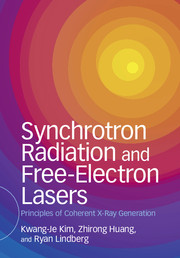Book contents
- Frontmatter
- Contents
- Preface
- Conventions and Notation
- 1 Preliminary Concepts
- 2 Synchrotron Radiation
- 3 Basic FEL Physics
- 4 1D FEL Analysis
- 5 3D FEL Analysis
- 6 Harmonic Generation in High-Gain FELs
- 7 FEL Oscillators and Coherent Hard X-Rays
- 8 Practical Considerations and Experimental Results for High-Gain FELs
- Appendix A Hamilton's Equations of Motion on Phase Space
- Appendix B Simulation Methods for FELs
- Appendix C Quantum Considerations for the FEL
- Appendix D Transverse Gradient Undulators
- Further Reading
- Index
Preface
Published online by Cambridge University Press: 06 April 2017
- Frontmatter
- Contents
- Preface
- Conventions and Notation
- 1 Preliminary Concepts
- 2 Synchrotron Radiation
- 3 Basic FEL Physics
- 4 1D FEL Analysis
- 5 3D FEL Analysis
- 6 Harmonic Generation in High-Gain FELs
- 7 FEL Oscillators and Coherent Hard X-Rays
- 8 Practical Considerations and Experimental Results for High-Gain FELs
- Appendix A Hamilton's Equations of Motion on Phase Space
- Appendix B Simulation Methods for FELs
- Appendix C Quantum Considerations for the FEL
- Appendix D Transverse Gradient Undulators
- Further Reading
- Index
Summary
X-rays produced when highly relativistic electrons are accelerated along a curved trajectory, generally referred to as synchrotron radiation, have served as an important tool for studying the structure and dynamics of various atomic and molecular systems. The first dedicated synchrotron radiation facility was built in the 1970s using an electron storage ring, and since that time the demand for synchrotron radiation has steadily increased due to its high intensity, narrow angular opening, and broad spectral coverage. Over the past few decades the effectiveness of synchrotron radiation has been further advanced by improvements in storage ring design that led to an increase in the electron beam phase space density, and by the use of magnetic devices such as undulators that dramatically increase the X-ray brightness over traditional bending magnets. These developments have widened and deepened the reach of “photon sciences” around the globe.
Another revolutionary advance in X-ray generation was made with the development of X-ray free-electron lasers (FELs). The radiation produced in an FEL acts back on the electron beam in a positive feedback loop, resulting in X-rays with dramatically improved intensity and coherence over those produced with storage-ring based sources. The X-ray FEL became feasible thanks to improvements in linear accelerator technology in general, and in particular to advances in the injector (electron source).
High-brightness, high-energy electron beams from a linear accelerator can now drive a high-gain X-ray FEL amplifier in a long undulator. The gain can be so high that the initially incoherent undulator radiation evolves to an intense, quasi-coherent field known as self-amplified spontaneous emission (SASE). The SASE pulse can be made ultrashort by using an ultrashort electron bunch. With X-ray FELs, experimental techniques developed for traditional synchrotron light sources can be made much more efficient, and new areas of material, chemistry, and biology research, such as ultrafast dynamics, have become accessible to study.
- Type
- Chapter
- Information
- Synchrotron Radiation and Free-Electron LasersPrinciples of Coherent X-Ray Generation, pp. ix - xiPublisher: Cambridge University PressPrint publication year: 2017

